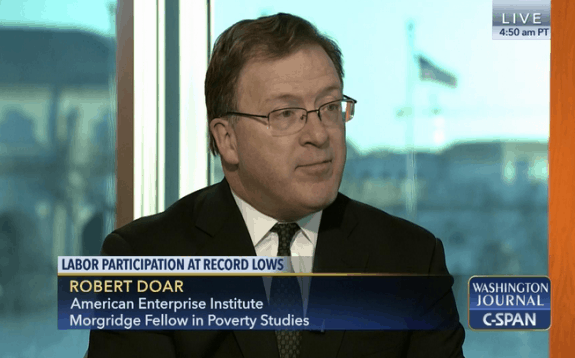
That move was never designed to be permanent.
Rather, the stated goal was to help the struggling through the recession and the potentially prolonged period of unemployment that resulted from it.
In 2016 and 2017 several states started to re-instate the work requirements that were part of bi-partisan reforms to welfare programs in the 1990s. Those generally mandated that individuals without dependents work, volunteer or participate in a work-training program 6-20 hours a week in order to receive benefits for more than a 3 month period.
In some places, regulations also limit how long an individual can receive assistance.

Though some argue that this is a bad idea, the numbers are showing that while there is a significant decrease in individuals enrolled in the SNAP program, the unemployment rate is also falling more rapidly under the Trump Administration.
“Welfare was never intended to be a one-way handout, but a program based on the idea of reciprocity,” said Robert Rector, a fellow at the conservative Heritage Foundation. “Those who receive benefits from the government should be required to work or participate in work-training as a condition.”

The idea behind the SNAP program is to help individuals and families in need afford groceries. Meanwhile, they could find work so that they will no longer have to rely on government assistance programs.
Now that employment opportunities are growing again, states that have re-implemented working requirements are seeing a significant drop in participation in the program. This saves taxpayers and protects often strained state and federal budgets.
From 2008 to 2013, when the waiver for these working requirements was introduced, the enrollment in the program increased by 70 percent – with a total of 47.6 million people receiving food stamps on a monthly basis in 2013. Now, in 2017, there are 42 million receiving food stamps, which is the lowest it has been since 2010, per Fox News.
“The greater good is people being employed, being productive, and contributing to the state,” Bobby Cage, Division of Family and Children Services director, told the Atlanta Journal-Constitution.

“Work requirements have been enormously successful at reducing the number of people on food stamps. And while they made sense in the early part of the recession when unemployment was higher, that is no longer the case,” Robert Doar, American Enterprise Institute poverty studies fellow, told the Journal-Constitution.
Employment is up, Wages are Rising…
…but not yet fast enough…
…The Problem with Housing Costs, And Professionals Like You
While many states, including Georgia, Maine, Florida, and Alabama, have all seen a drop in the number of people relying on food stamps, it doesn’t mean that nagging economic problems are resolved.
The cost of living has continued to grow in recent years, pricing many low-wage workers out of their homes. An upcoming article on the Daily Business News will go into deeper detail on the high price of market rental rates.
Though SNAP has helped these individuals through job-training programs, or job-placement programs offered locally, these same people often end up earning just enough to pass being eligible for food stamps, but are still not making quite enough to live.
“Most of these people have lower-paying jobs, and everything keeps going up and up and up,” said said Alvin Bagwell, director of Good Samaritan Ministries of Northeast Georgia. “Rent is a good thing to look at. You go out and try to rent a house now, what used to cost you $750, $800 will cost you $1,200 or $1,300 a month — if you can find a house to rent.”
According to the Gainesville Times, the number of people turning to charities and food pantries to keep their utilities on and food on the table has increased since working requirements went back into effect in the state of Georgia. Likely, this same trend follows in the other states where working requirements have been reinstated.
“Parents will work just as hard at unforgiving jobs and see less food on the table for their families. Children will become sicker without the proper nutrition, ending up in hospitals or on the rolls of what social services remain. Some children will die,” Mariana Chilton, a professor of public health at Drexel University, predicted a column for The Hill.

A solution for many is Manufactured Housing
“The focus of these programs should be on how we can help adults get their families to a better way of life,” Rep. Jim Jordan, R-Ohio said to Fox News.
Now that the nation is working towards increasing the work force and reducing the number of people relying on government assistance such as food stamps, one focus factory built housing industry marketers can look to is ways to attract those who can save significantly on their housing costs.
Manufactured housing offers that solution in a variety of markets. As MHARR routinely points out, those hard working Americans with low incomes deserve the opportunity that manufactured homes uniquely offer Americans.
With housing often being the single greatest expense – and part of the 5 essentials of food, clothing, transportation and shelter – addressing the perception issues could fill that gap in the supply and demand chain.
While Trumponomics seems to be moving the nation in a steadily improved financial direction, news like the above is often blurred by the steady drum beat of an often hostile media and opponents from across the political spectrum.
In just over 6 months, the White House tells MHProNews in a release today that some $4 trillion dollars have been added to the markets.
Those stocks are often part of the retirement and investment funds of middle income Americans. That too spells growing opportunities for professionals that serve more upwardly mobile housing seekers. ## (Closing pun intended, news, analysis.)
(Image credits are as shown above, and when provided by third parties, are shared under fair use guidelines.)

